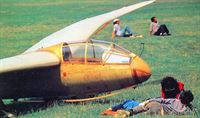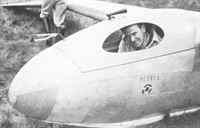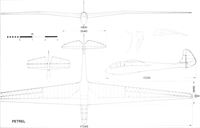
Варианты
- Schleicher - Rhonadler - 1932 - Германия
- Slingsby - T.13 Petrel - 1938 - Великобритания
M.Simons The World's Vintage Sailplanes 1908-45
THE KIRBY PETREL
In 1938 the speedway rider Frank Charles visited Slingsby’s factory and asked the firm to build for him an improved version of the Rhoenadler. The design was not to be altered fundamentally but the wing was to be given the ‘gull’ form. By cranking the wing down toward the centre, the roots could be faired neatly into the streamlined fuselage at shoulder level. For the cockpit canopy Charles returned to an older idea. The canopy was made wholly of plywood with large portholes. He believed the airflow would be smoother, even with the holes, than over the wooden-framed transparent type.
The Petrel made its first flight in December, 1938. Orders for eight were received but they were to be fitted with transparent canopies and some were to have fixed tailplanes with elevators. Two Petrels entered the British National Competitions in 1939. Saturday 12th July was tragic, and gave the Petrel a dubious place in the history of soaring. Charles took oil on a winch launch in conditions of low cloud and occasional rain showers. As he climbed he entered cloud and the winch driver reduced power, expecting the glider to release the cable. Charles emerged from the cloud, and turned downwind, cable still on. The winch driver was unable to cut the cable in time, the glider was pulled up sharply at the end of its tether, and dived vertically to the ground. Charles was killed instantly. The accident was witnessed by John Furlong, who, with his friend Leonard Ottley, later developed the OTTFUR safety release for sailplanes. Many lives have been saved since then, and now no sailplane is launched by winch or car tow without either an OTTFUR or some equivalent type of ‘back release'.
Only three Petrels were completed by the Slingsby works. One was wrecked in the accident: the other two still survive and fly regularly in Britain. One has a pendulum elevator and the other has a fixed tailplane with hinged elevator.
Technical data:
Petrel: Span. 17.34 m. Wing area. 16.72 sq m. Aspect ratio. 17.9. Empty weight. 199.5 kg. Flying weight. 289.5 kg. Wing loading. 17.5 kg/sq m. Wing section. Goettingen 652 modified (as on Rhoenadler) at the roots, tapering to Clark YH with washout at the tips.
Описание:
- M.Simons The World's Vintage Sailplanes 1908-45
- M.Hardy. Gliders & Sailplanes of the world
Фотографии
-
GL / M.Simons - The World's Vintage Sailplanes 1908-45 /Kookaburra/
The white Petrel, owned and restored by Ron Davidson. This has a modern moulded cockpit canopy and is covered with heat-shrunk plastic fabric. The tailplane is of the all-moving type.
-
Aeroplane Monthly 1994-11 / M.Oakey - Grapevine
The third and last Slingsby Petrel under aero tow over Lasham.
-
GL / M.Simons - The World's Vintage Sailplanes 1908-45 /Kookaburra/
The Russavia Petrel, with fuselage returned to its clear varnished state. Some signs of small repairs are detectable. This aircraft has a fixed tailplane with hinged elevator.
-
GL / M.Simons - The World's Vintage Sailplanes 1908-45 /Kookaburra/
Frank Charles in the cockpit of the prototype.
-
Aeroplane Monthly 1993-09 / M.Simons - Sling's sailplanes (11)
Регистрационный номер: BGA418 [2] A post-war photograph of Slingsby Petrel BGA 418 in flight, taken by Charles E. Brown.
-
Aeroplane Monthly 1993-09 / M.Simons - Sling's sailplanes (11)
The contest number 19 and the transparent canopy identify this Petrel as that flown by P. M. Watt, taking a winch launch at the 1939 National Competitions held in July at Camphill, Derbyshire.
-
Aeroplane Monthly 1993-09 / M.Simons - Sling's sailplanes (11)
Регистрационный номер: BGA651 [4] Petrel BGA 651 has been restored partly to its original clear-doped and varnish finish. It is seen here at a vintage glider rally at Sutton Bank.
-
Aeroplane Monthly 1993-09 / M.Simons - Sling's sailplanes (11)
Регистрационный номер: BGA651 [4] The only Petrel built with a fixed tailplane, BGA 651 flew in Eire for many years and was retired to a museum. It was returned to England in 1973 and restored to flying condition and became part of the Russavia collection. The wheeled dolly is dropped after take-off.
-
GL / M.Simons - The World's Vintage Sailplanes 1908-45 /Kookaburra/
Регистрационный номер: BGA651 [4] The third Petrel, with enlarged fixed tailplane and hinged elevator instead of the all-moving tailplane of the prototype. In 1973 it was bought for the Russavia collection and restored by Mike Russell. As shown here it was painted red and cream but since then the fuselage has been stripped and restored to the original finish.
-
Aeroplane Monthly 1993-09 / M.Simons - Sling's sailplanes (11)
Регистрационный номер: BGA418 [2], BGA651 [4] Left, the instrument panel of BGA 418. The knob on the left is for the tow release.
Right, the instrument panel of BGA 651. The tuft of wool on the pitot tube is the most sensitive slip indicator available, and the cheapest. -
Aeroplane Monthly 1993-09 / M.Simons - Sling's sailplanes (11)
Slingsby Type 13 Petrel
- Фотографии












